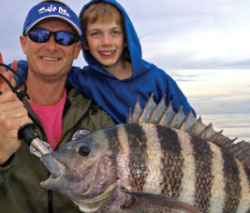When a fish hits your lure at speeds of up to 60 miles per hour and your reel starts screaming as it dumps a couple hundred yards of line in a few seconds, you’ll quickly understand why they call this bullet-looking fish a “Wahoooooo”.
The initial run that this extremely fast fish makes is the reason why wahoo fishing provides anglers with one of the most exciting fights they will ever experience. The Wahoo’s speed, strength and taste make this pelagic one of the most highly prized sport fish in the world.
Wahoo (Acanthocybium solandri) are found worldwide in tropical and sub- tropical areas. Besides its speed and strength, the wahoo is also known for its delicious meat. They have one of the most desirable, firm and mildtasting white meats you will find in the ocean. Whether you are putting it in a sushi roll or eating it as sashimi or ceviche, this fish is best served raw. When preparing wahoo, treat it as if it were yellow fin tuna; or if you decide to cook it, then be sure you cook it quickly because this fish will dry out fast and it’s easily overcooked. When properly prepared, the wahoo is considered to be one of the best eating fish in the world; however, you’ll have to catch it first!
One of the most common ways to target “hoos” is trolling. There are a few different tactics used when trolling and this varies depending upon the ocean conditions, bait in the area and how the fish are behaving on a particular day. Some trolling methods include: typical wahoo lures with speeds of 6-9 knots, hard baits and lip lures at 4-6 knots, high-speed C&H lures and downriggers at speeds up to 18 knots, or bump-trolling live bait.
If you are using hard bait, such as the deep-diving Yo-Zuri Hydro Magnum lures, or the Yo-Zuri Bonito, your speed should be 5 to 9 knots. Wahoo go crazy over deep diving lures! These types of lures are best trolled over wrecks and other large structures; it will significantly increase your chances of getting hit. Another advantage of using this lure is that it can also attract other very desirable species of fish besides the wahoo, like tuna, king fish and dolphin. Lipped hard baits are also a great choice when the fish are deeper and you want to get your lure 20 to 40 feet below the surface. Midday and high-sun situations generally call for a lure like this because it’s easier for a wahoo to see the bait when it is deep in the water column, instead of looking up into the blinding sun.
If for some reason the fish in your area are being picky and you happen to have plenty of ballyhoo around, then a good tactic to try would be bum trolling with live rigged ballyhoo, goggle eyes or the most abundant bait in your area. When using live bait, move your boat slowly or just bump it in and out of gear, so you don’t drown your bait. Make sure you are rigged with at least 15 inches of wire leader and a 10/0 Mustad “J” Hook, which is a very strong hook necessary to bring this powerful fish to the boat.
Another popular method of trolling for Wahoo is high-speed trolling at 10-14 knots. A very select crowd will even troll at speeds up to 16-18 knots, which might not be as effective as 10 knots, but it still works since the wahoo can swim at up to 60 miles per hour! One thing is for sure; you are not going to drag your lures faster than a wahoo can swim. The reason trolling at slower speeds is more effective is because you keep your bait and lures in the strike zone for a longer period of time. Wahoo, like most other fish, pray on weaker and injured bait. For most anglers, the only time they use this method is when they are unsure of the fish’s location or are trying to cover a lot of ground in a short period of time. Once you find the fish, the best thing to do is to slow down and troll at 6-9 knots over that area; you want to try and pick up fish that may be less aggressive and aren’t willing to chase a lure down at 18 knots.
After selecting the technique that works best for you and hooking into a wahoo, make sure you keep the boat in gear and do not slow down until the angler is completely ready to fight the fish. After the Wahoo’s initial run, it is not uncommon for the wahoo to swim straight towards the boat; it will most likely shake its head aggressively trying to throw the hook. The angler needs to keep the tip of the rod up the whole time while fighting the fish; “Let the rod do the work”, if the rod is pointed directly at the fish, chances are good that the hook could pull loose. When the fish starts to get close, the boat should be moving at about 5 knots and the angler should bring the fish to the side of the boat to make it easier to gaff. Once the wahoo has been gaffed, swing him directly into your Grizzly cooler, but watch out for the razor-sharp teeth that can do some serious damage!
It doesn’t matter where you are fishing, targeting this powerful fish requires heavy tackle, so make sure you have a few heavy-duty Shimano rods and 50W or 80W Tiagra Shimano reels that can hold between 600-1200 yards of 50 to 80 pound mono line. This amount of line will help you survive the initial hit and run from this awesome fish. Regardless of the trolling method you prefer, we are all after the same thing, getting the fish in the boat and onto the dinner table.
photos by Captain Jimmy Nelson





